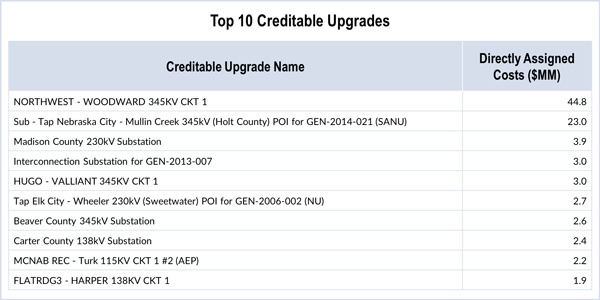By Tom Kleckner
SPP stakeholders are considering the use of incremental long-term congestion rights (ILTCRs) to help solve some of the complexity with the RTO’s Z2 crediting process, a contentious issue that dates back to 2008.
Meeting in Kansas City last week, the Z2 Task Force spent considerable time discussing ILTCRs — a form of financial transmission rights used by most other RTOs and already included in SPP’s Tariff — as part of the transmission-congestion rights market.

The top 10 creditable upgrades represent $89.4 million, more than three-quarters of the total Z-2 assessments. | SPP
In lieu of cash compensation, upgrade sponsors would be eligible to receive ILTCRs as credit for their financial contributions to grid improvements, as the upgrades increase the available transfer capability on the system.
SPP’s outside legal counsel, D.C.-based Wright & Talisman, provided the results of its research on how other RTOs’ Tariffs compensate entities that sponsor network transmission upgrades. CAISO, ISO-NE, MISO, NYISO and PJM all apply some form of compensation through congestion rights or incremental auction revenue rights, according to the report.
“While the terminology, form, amount and duration varies from RTO to RTO,” the report said, “most RTOs provide these incremental ARRs on a long-term basis based on the incremental transfer capability provided by the upgrade.”

Buffington | © RTO Insider
SPP’s TCR “market is still a little bit different than MISO or PJM’s, because SPP models on point of delivery, whereas in other markets it’s financial,” said Denise Buffington, Kansas City Power & Light’s director of energy policy and corporate counsel, and the task force chair.
The task force will continue its discussion with an educational session in Dallas on Nov. 29, during which it will bring in several subject matter experts to help the group examine SPP’s TCR market and its generation interconnection and aggregate study processes, among other items.
“I want more information. I don’t want to go into the weeds, but I want to know the pressure points and how one impacts the other … and begin connecting the dots,” Buffington said. “The problem we still face is an education problem. Every time we talk about [Z2], we learn something new — or about something else that touches it.”
In addition to ILCTRs, the group discussed five other options staff offered to improve the Z2 process:
- Base plan funding: All upgrades, regardless of their origin, would be included in the current cost allocation methodology. This would recognize that the regional planning and operational processes will optimize all the available transmission.
- Reverse engineering: SPP staff has reverse engineered the Z2 process and its associated data inputs, identifying potential modifications to simplify the process, including annual Z2 billing; revising the Tariff’s transmission payment schedules; removing short-term transmission service requests (TSRs) from the process; using annual transmission revenue requirements for point-to-point credit-payment obligations; posting impact ratios for each TSR; using an alternate source for transmission distribution factors; removing short-term TSRs from stacking; and a hybrid solution combining most of the modifications.
- Upgrade sponsor-facilities rider (USFR): Consistent with the current Z2 revenue crediting process, sponsors would retain responsibility for reimbursing the owner that builds the creditable-upgrade facilities and the funds used to compensate the sponsors collected from users of the facilities. The process would be simplified by substituting a USFR in part of the crediting process by recovering the facilities’ engineering and construction costs over a specified number of months. The USFR rate would be an add-on charge applicable only to customers using the creditable-upgrade facilities, and funds would be distributed to the sponsor.
- Construction credits: Allows the upgrade’s sponsor to receive credits against its transmission service invoice up to, but not above, the amount of engineering and construction costs paid to the entity that built the upgrade.
- Toll-road option: Similar to the approach used to fund toll roads, the funding entity is repaid over time by those who use the upgrade. Staff would calculate transmission impacts on a new facility once it is constructed, and all subsequent customers would be charged a fee for use of the line. The sponsor would receive funding from that use until it recoups to the cost of the facility.
All of the options are still in play. Buffington told her fellow stakeholders she hopes they bring their own proposals or a ranking of those on the table to a January task force meeting before the Markets and Operations Policy Committee meeting. The task force expects to finish its work by April.
In the interim, staff will review the Z2 process to identify FERC-mandated requirements and SPP’s own additions and provide the task force with background on why certain requirements were placed in the Tariff. Staff was also asked to develop an annual cost estimate for ongoing support of the Z2 system and to document how it will model fixes and improvements.
SPP’s Board of Directors formed the task force in July to address Z2 waiver requests from members for directly assigned upgrade costs and to improve the process going forward. SPP has billed members for almost $110 million in regionwide, aggregate net payable historic amounts for Z2 credits and obligations, some of which date back to 2008.




